Tax
VerifiedAdded on 2023/06/07
|9
|2531
|268
AI Summary
This report discusses the accounting process and tax implication of Frank Lloyd. It suggests the appropriate accounting method and software for Frank. It also evaluates the available deductible tax incomes of Ruby Engineering Pty Ltd upon the transactions of the year 2018.
Contribute Materials
Your contribution can guide someone’s learning journey. Share your
documents today.
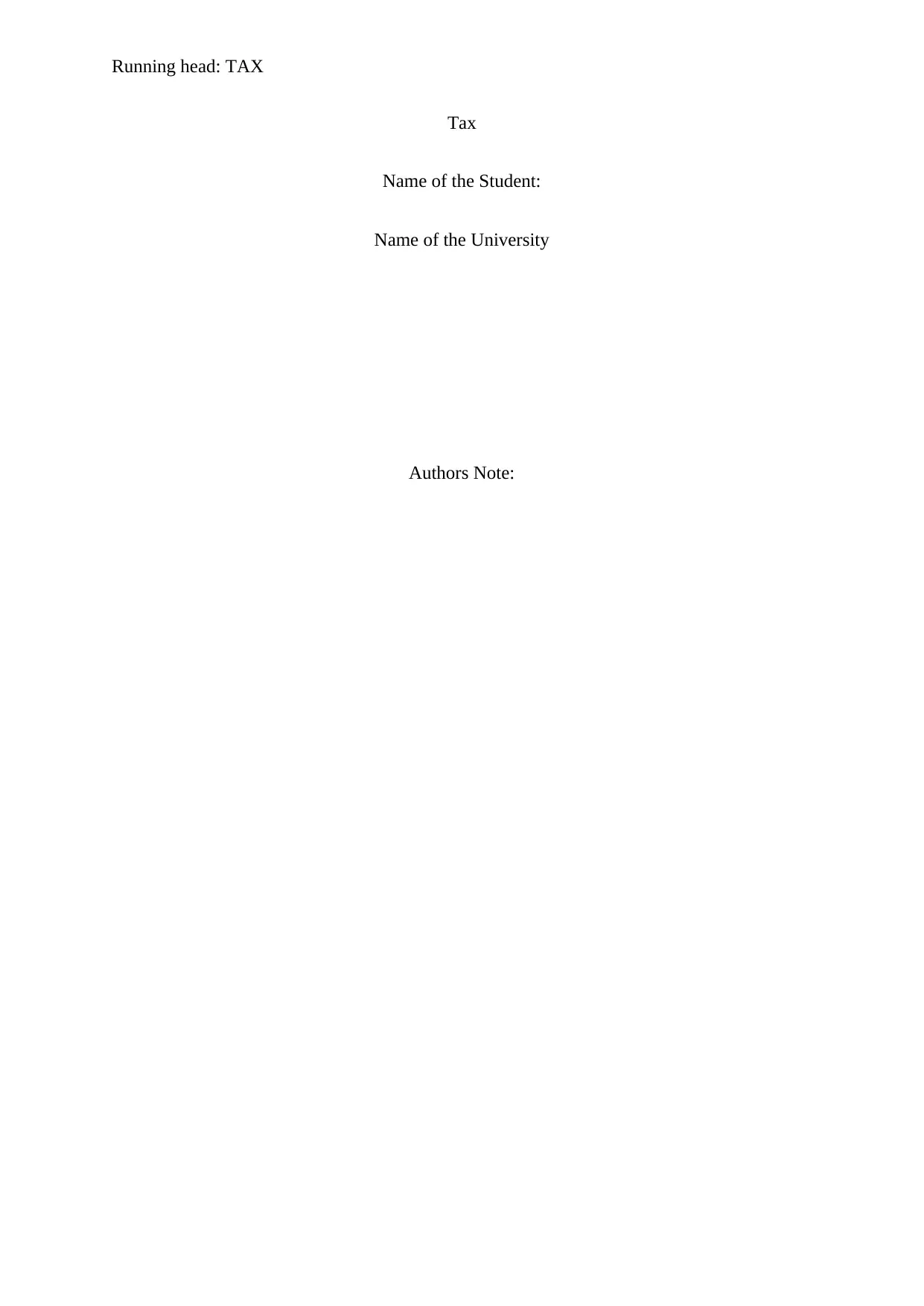
Running head: TAX
Tax
Name of the Student:
Name of the University
Authors Note:
Tax
Name of the Student:
Name of the University
Authors Note:
Secure Best Marks with AI Grader
Need help grading? Try our AI Grader for instant feedback on your assignments.
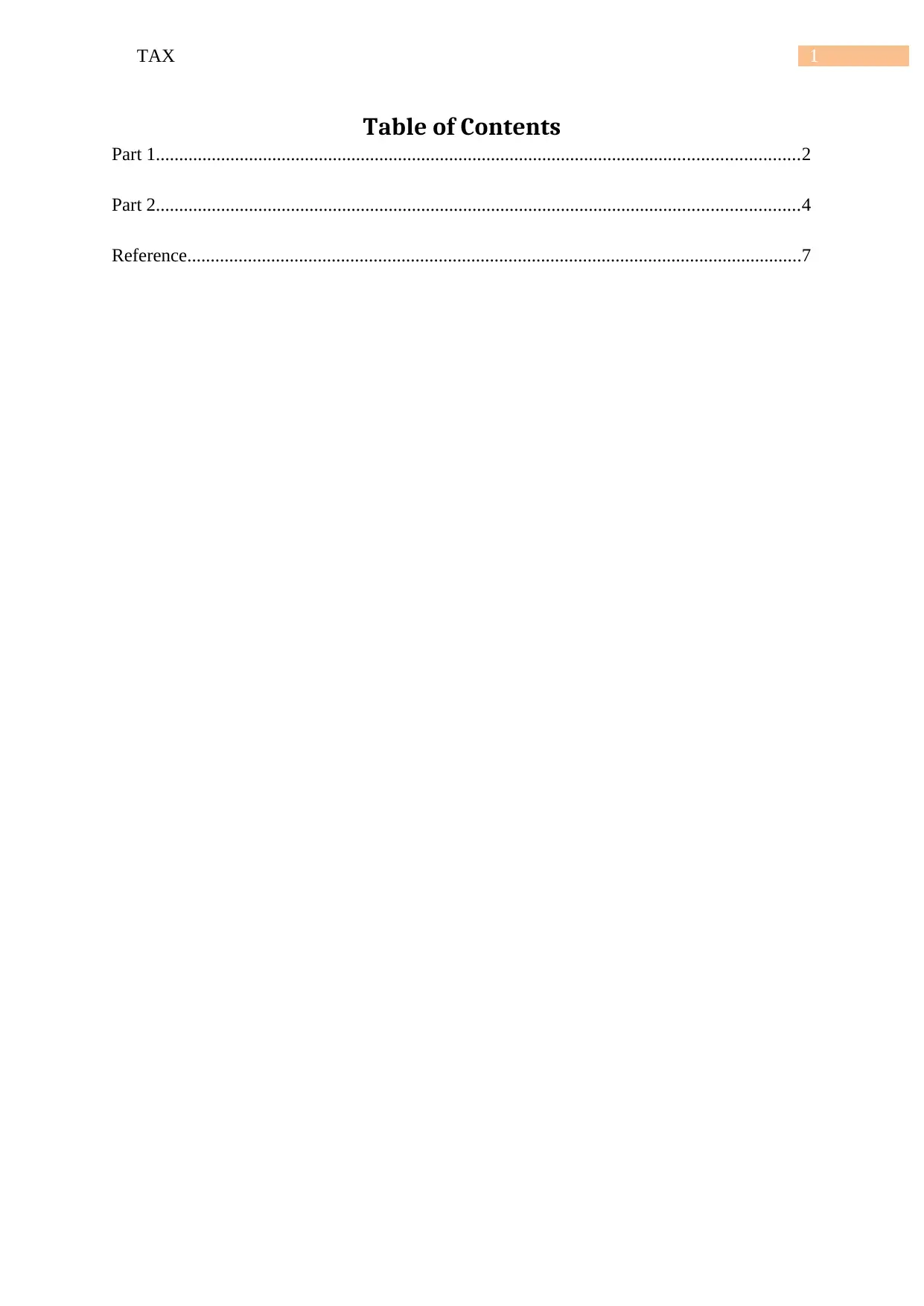
1TAX
Table of Contents
Part 1..........................................................................................................................................2
Part 2..........................................................................................................................................4
Reference....................................................................................................................................7
Table of Contents
Part 1..........................................................................................................................................2
Part 2..........................................................................................................................................4
Reference....................................................................................................................................7
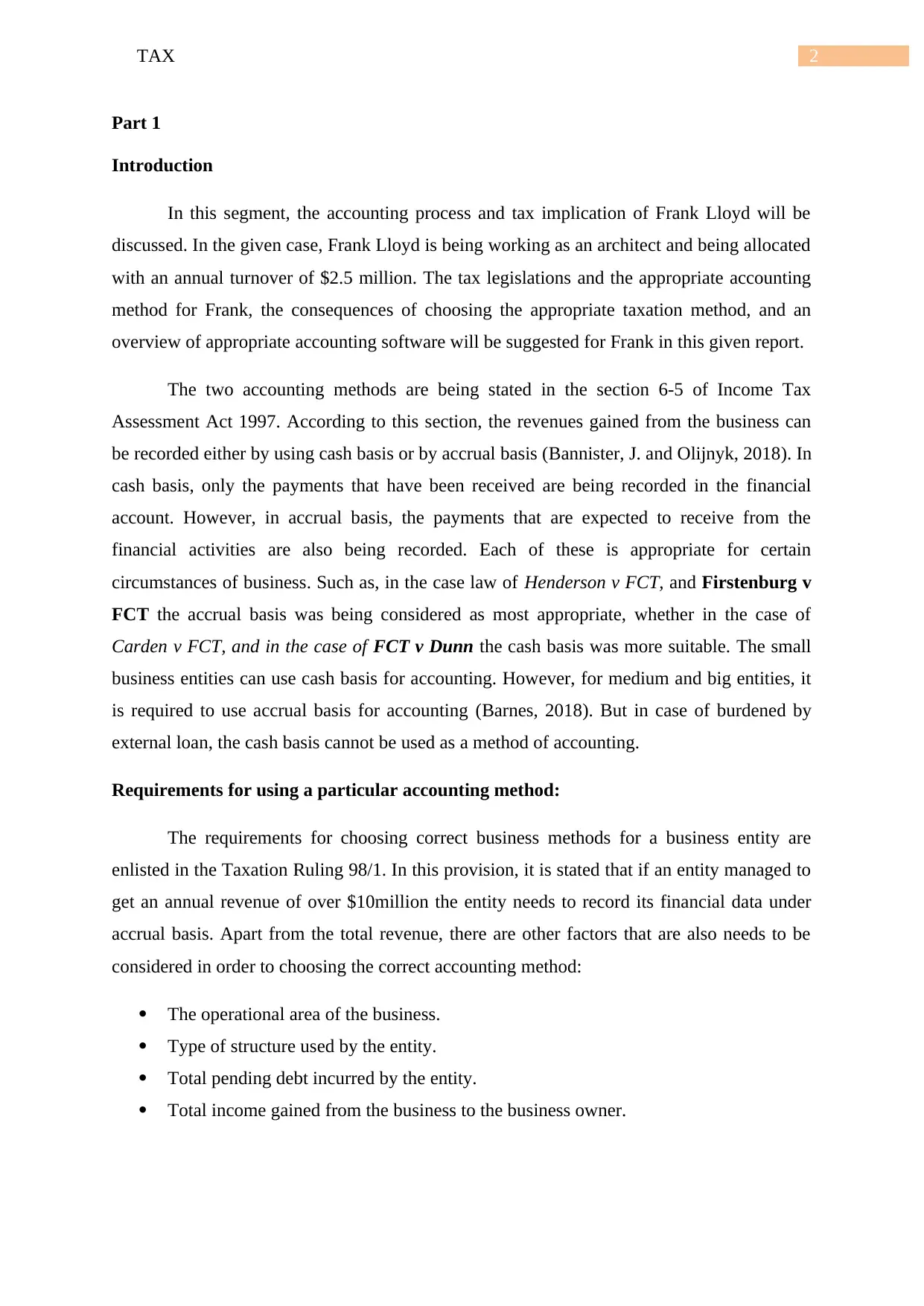
2TAX
Part 1
Introduction
In this segment, the accounting process and tax implication of Frank Lloyd will be
discussed. In the given case, Frank Lloyd is being working as an architect and being allocated
with an annual turnover of $2.5 million. The tax legislations and the appropriate accounting
method for Frank, the consequences of choosing the appropriate taxation method, and an
overview of appropriate accounting software will be suggested for Frank in this given report.
The two accounting methods are being stated in the section 6-5 of Income Tax
Assessment Act 1997. According to this section, the revenues gained from the business can
be recorded either by using cash basis or by accrual basis (Bannister, J. and Olijnyk, 2018). In
cash basis, only the payments that have been received are being recorded in the financial
account. However, in accrual basis, the payments that are expected to receive from the
financial activities are also being recorded. Each of these is appropriate for certain
circumstances of business. Such as, in the case law of Henderson v FCT, and Firstenburg v
FCT the accrual basis was being considered as most appropriate, whether in the case of
Carden v FCT, and in the case of FCT v Dunn the cash basis was more suitable. The small
business entities can use cash basis for accounting. However, for medium and big entities, it
is required to use accrual basis for accounting (Barnes, 2018). But in case of burdened by
external loan, the cash basis cannot be used as a method of accounting.
Requirements for using a particular accounting method:
The requirements for choosing correct business methods for a business entity are
enlisted in the Taxation Ruling 98/1. In this provision, it is stated that if an entity managed to
get an annual revenue of over $10million the entity needs to record its financial data under
accrual basis. Apart from the total revenue, there are other factors that are also needs to be
considered in order to choosing the correct accounting method:
The operational area of the business.
Type of structure used by the entity.
Total pending debt incurred by the entity.
Total income gained from the business to the business owner.
Part 1
Introduction
In this segment, the accounting process and tax implication of Frank Lloyd will be
discussed. In the given case, Frank Lloyd is being working as an architect and being allocated
with an annual turnover of $2.5 million. The tax legislations and the appropriate accounting
method for Frank, the consequences of choosing the appropriate taxation method, and an
overview of appropriate accounting software will be suggested for Frank in this given report.
The two accounting methods are being stated in the section 6-5 of Income Tax
Assessment Act 1997. According to this section, the revenues gained from the business can
be recorded either by using cash basis or by accrual basis (Bannister, J. and Olijnyk, 2018). In
cash basis, only the payments that have been received are being recorded in the financial
account. However, in accrual basis, the payments that are expected to receive from the
financial activities are also being recorded. Each of these is appropriate for certain
circumstances of business. Such as, in the case law of Henderson v FCT, and Firstenburg v
FCT the accrual basis was being considered as most appropriate, whether in the case of
Carden v FCT, and in the case of FCT v Dunn the cash basis was more suitable. The small
business entities can use cash basis for accounting. However, for medium and big entities, it
is required to use accrual basis for accounting (Barnes, 2018). But in case of burdened by
external loan, the cash basis cannot be used as a method of accounting.
Requirements for using a particular accounting method:
The requirements for choosing correct business methods for a business entity are
enlisted in the Taxation Ruling 98/1. In this provision, it is stated that if an entity managed to
get an annual revenue of over $10million the entity needs to record its financial data under
accrual basis. Apart from the total revenue, there are other factors that are also needs to be
considered in order to choosing the correct accounting method:
The operational area of the business.
Type of structure used by the entity.
Total pending debt incurred by the entity.
Total income gained from the business to the business owner.
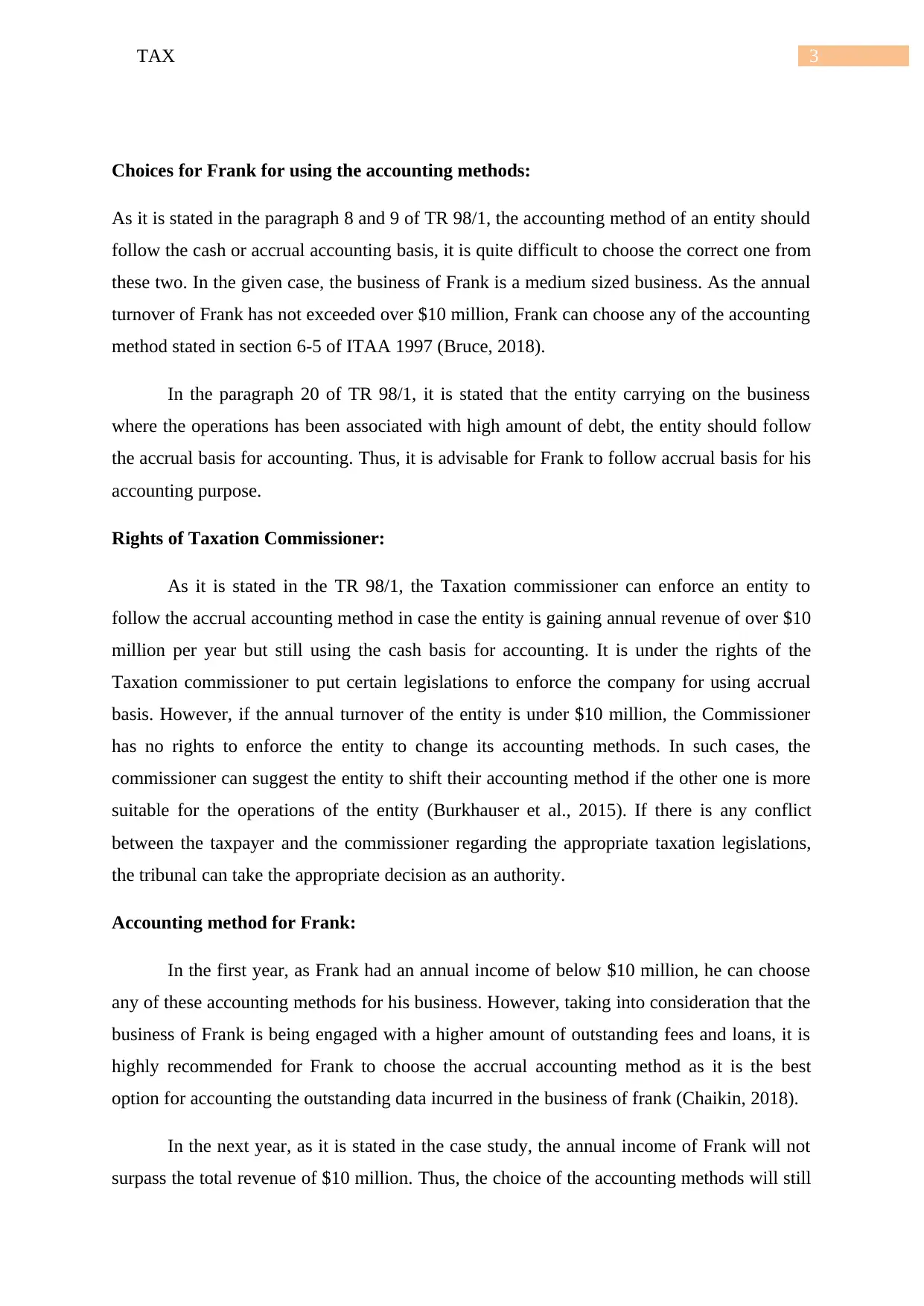
3TAX
Choices for Frank for using the accounting methods:
As it is stated in the paragraph 8 and 9 of TR 98/1, the accounting method of an entity should
follow the cash or accrual accounting basis, it is quite difficult to choose the correct one from
these two. In the given case, the business of Frank is a medium sized business. As the annual
turnover of Frank has not exceeded over $10 million, Frank can choose any of the accounting
method stated in section 6-5 of ITAA 1997 (Bruce, 2018).
In the paragraph 20 of TR 98/1, it is stated that the entity carrying on the business
where the operations has been associated with high amount of debt, the entity should follow
the accrual basis for accounting. Thus, it is advisable for Frank to follow accrual basis for his
accounting purpose.
Rights of Taxation Commissioner:
As it is stated in the TR 98/1, the Taxation commissioner can enforce an entity to
follow the accrual accounting method in case the entity is gaining annual revenue of over $10
million per year but still using the cash basis for accounting. It is under the rights of the
Taxation commissioner to put certain legislations to enforce the company for using accrual
basis. However, if the annual turnover of the entity is under $10 million, the Commissioner
has no rights to enforce the entity to change its accounting methods. In such cases, the
commissioner can suggest the entity to shift their accounting method if the other one is more
suitable for the operations of the entity (Burkhauser et al., 2015). If there is any conflict
between the taxpayer and the commissioner regarding the appropriate taxation legislations,
the tribunal can take the appropriate decision as an authority.
Accounting method for Frank:
In the first year, as Frank had an annual income of below $10 million, he can choose
any of these accounting methods for his business. However, taking into consideration that the
business of Frank is being engaged with a higher amount of outstanding fees and loans, it is
highly recommended for Frank to choose the accrual accounting method as it is the best
option for accounting the outstanding data incurred in the business of frank (Chaikin, 2018).
In the next year, as it is stated in the case study, the annual income of Frank will not
surpass the total revenue of $10 million. Thus, the choice of the accounting methods will still
Choices for Frank for using the accounting methods:
As it is stated in the paragraph 8 and 9 of TR 98/1, the accounting method of an entity should
follow the cash or accrual accounting basis, it is quite difficult to choose the correct one from
these two. In the given case, the business of Frank is a medium sized business. As the annual
turnover of Frank has not exceeded over $10 million, Frank can choose any of the accounting
method stated in section 6-5 of ITAA 1997 (Bruce, 2018).
In the paragraph 20 of TR 98/1, it is stated that the entity carrying on the business
where the operations has been associated with high amount of debt, the entity should follow
the accrual basis for accounting. Thus, it is advisable for Frank to follow accrual basis for his
accounting purpose.
Rights of Taxation Commissioner:
As it is stated in the TR 98/1, the Taxation commissioner can enforce an entity to
follow the accrual accounting method in case the entity is gaining annual revenue of over $10
million per year but still using the cash basis for accounting. It is under the rights of the
Taxation commissioner to put certain legislations to enforce the company for using accrual
basis. However, if the annual turnover of the entity is under $10 million, the Commissioner
has no rights to enforce the entity to change its accounting methods. In such cases, the
commissioner can suggest the entity to shift their accounting method if the other one is more
suitable for the operations of the entity (Burkhauser et al., 2015). If there is any conflict
between the taxpayer and the commissioner regarding the appropriate taxation legislations,
the tribunal can take the appropriate decision as an authority.
Accounting method for Frank:
In the first year, as Frank had an annual income of below $10 million, he can choose
any of these accounting methods for his business. However, taking into consideration that the
business of Frank is being engaged with a higher amount of outstanding fees and loans, it is
highly recommended for Frank to choose the accrual accounting method as it is the best
option for accounting the outstanding data incurred in the business of frank (Chaikin, 2018).
In the next year, as it is stated in the case study, the annual income of Frank will not
surpass the total revenue of $10 million. Thus, the choice of the accounting methods will still
Secure Best Marks with AI Grader
Need help grading? Try our AI Grader for instant feedback on your assignments.
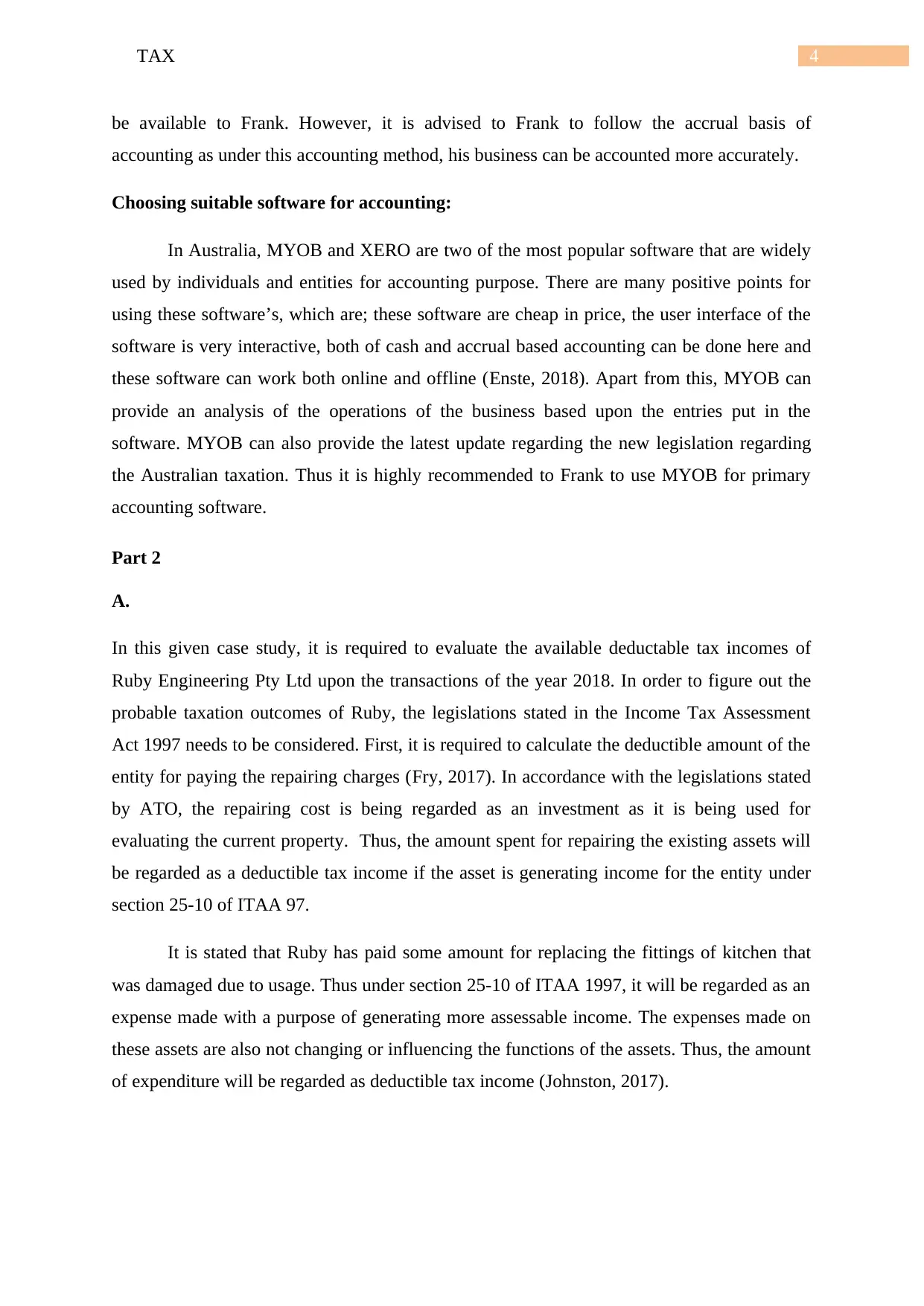
4TAX
be available to Frank. However, it is advised to Frank to follow the accrual basis of
accounting as under this accounting method, his business can be accounted more accurately.
Choosing suitable software for accounting:
In Australia, MYOB and XERO are two of the most popular software that are widely
used by individuals and entities for accounting purpose. There are many positive points for
using these software’s, which are; these software are cheap in price, the user interface of the
software is very interactive, both of cash and accrual based accounting can be done here and
these software can work both online and offline (Enste, 2018). Apart from this, MYOB can
provide an analysis of the operations of the business based upon the entries put in the
software. MYOB can also provide the latest update regarding the new legislation regarding
the Australian taxation. Thus it is highly recommended to Frank to use MYOB for primary
accounting software.
Part 2
A.
In this given case study, it is required to evaluate the available deductable tax incomes of
Ruby Engineering Pty Ltd upon the transactions of the year 2018. In order to figure out the
probable taxation outcomes of Ruby, the legislations stated in the Income Tax Assessment
Act 1997 needs to be considered. First, it is required to calculate the deductible amount of the
entity for paying the repairing charges (Fry, 2017). In accordance with the legislations stated
by ATO, the repairing cost is being regarded as an investment as it is being used for
evaluating the current property. Thus, the amount spent for repairing the existing assets will
be regarded as a deductible tax income if the asset is generating income for the entity under
section 25-10 of ITAA 97.
It is stated that Ruby has paid some amount for replacing the fittings of kitchen that
was damaged due to usage. Thus under section 25-10 of ITAA 1997, it will be regarded as an
expense made with a purpose of generating more assessable income. The expenses made on
these assets are also not changing or influencing the functions of the assets. Thus, the amount
of expenditure will be regarded as deductible tax income (Johnston, 2017).
be available to Frank. However, it is advised to Frank to follow the accrual basis of
accounting as under this accounting method, his business can be accounted more accurately.
Choosing suitable software for accounting:
In Australia, MYOB and XERO are two of the most popular software that are widely
used by individuals and entities for accounting purpose. There are many positive points for
using these software’s, which are; these software are cheap in price, the user interface of the
software is very interactive, both of cash and accrual based accounting can be done here and
these software can work both online and offline (Enste, 2018). Apart from this, MYOB can
provide an analysis of the operations of the business based upon the entries put in the
software. MYOB can also provide the latest update regarding the new legislation regarding
the Australian taxation. Thus it is highly recommended to Frank to use MYOB for primary
accounting software.
Part 2
A.
In this given case study, it is required to evaluate the available deductable tax incomes of
Ruby Engineering Pty Ltd upon the transactions of the year 2018. In order to figure out the
probable taxation outcomes of Ruby, the legislations stated in the Income Tax Assessment
Act 1997 needs to be considered. First, it is required to calculate the deductible amount of the
entity for paying the repairing charges (Fry, 2017). In accordance with the legislations stated
by ATO, the repairing cost is being regarded as an investment as it is being used for
evaluating the current property. Thus, the amount spent for repairing the existing assets will
be regarded as a deductible tax income if the asset is generating income for the entity under
section 25-10 of ITAA 97.
It is stated that Ruby has paid some amount for replacing the fittings of kitchen that
was damaged due to usage. Thus under section 25-10 of ITAA 1997, it will be regarded as an
expense made with a purpose of generating more assessable income. The expenses made on
these assets are also not changing or influencing the functions of the assets. Thus, the amount
of expenditure will be regarded as deductible tax income (Johnston, 2017).
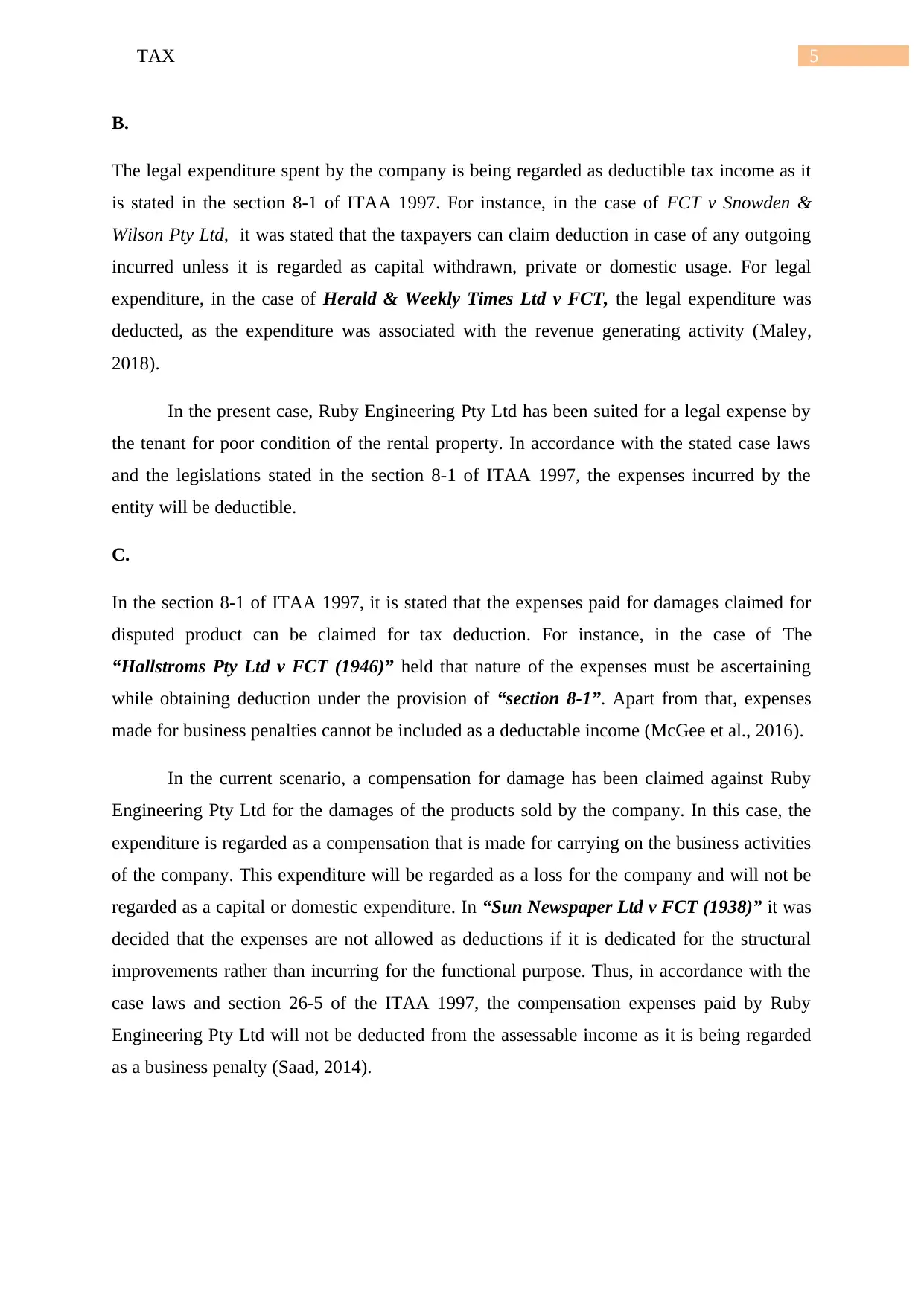
5TAX
B.
The legal expenditure spent by the company is being regarded as deductible tax income as it
is stated in the section 8-1 of ITAA 1997. For instance, in the case of FCT v Snowden &
Wilson Pty Ltd, it was stated that the taxpayers can claim deduction in case of any outgoing
incurred unless it is regarded as capital withdrawn, private or domestic usage. For legal
expenditure, in the case of Herald & Weekly Times Ltd v FCT, the legal expenditure was
deducted, as the expenditure was associated with the revenue generating activity (Maley,
2018).
In the present case, Ruby Engineering Pty Ltd has been suited for a legal expense by
the tenant for poor condition of the rental property. In accordance with the stated case laws
and the legislations stated in the section 8-1 of ITAA 1997, the expenses incurred by the
entity will be deductible.
C.
In the section 8-1 of ITAA 1997, it is stated that the expenses paid for damages claimed for
disputed product can be claimed for tax deduction. For instance, in the case of The
“Hallstroms Pty Ltd v FCT (1946)” held that nature of the expenses must be ascertaining
while obtaining deduction under the provision of “section 8-1”. Apart from that, expenses
made for business penalties cannot be included as a deductable income (McGee et al., 2016).
In the current scenario, a compensation for damage has been claimed against Ruby
Engineering Pty Ltd for the damages of the products sold by the company. In this case, the
expenditure is regarded as a compensation that is made for carrying on the business activities
of the company. This expenditure will be regarded as a loss for the company and will not be
regarded as a capital or domestic expenditure. In “Sun Newspaper Ltd v FCT (1938)” it was
decided that the expenses are not allowed as deductions if it is dedicated for the structural
improvements rather than incurring for the functional purpose. Thus, in accordance with the
case laws and section 26-5 of the ITAA 1997, the compensation expenses paid by Ruby
Engineering Pty Ltd will not be deducted from the assessable income as it is being regarded
as a business penalty (Saad, 2014).
B.
The legal expenditure spent by the company is being regarded as deductible tax income as it
is stated in the section 8-1 of ITAA 1997. For instance, in the case of FCT v Snowden &
Wilson Pty Ltd, it was stated that the taxpayers can claim deduction in case of any outgoing
incurred unless it is regarded as capital withdrawn, private or domestic usage. For legal
expenditure, in the case of Herald & Weekly Times Ltd v FCT, the legal expenditure was
deducted, as the expenditure was associated with the revenue generating activity (Maley,
2018).
In the present case, Ruby Engineering Pty Ltd has been suited for a legal expense by
the tenant for poor condition of the rental property. In accordance with the stated case laws
and the legislations stated in the section 8-1 of ITAA 1997, the expenses incurred by the
entity will be deductible.
C.
In the section 8-1 of ITAA 1997, it is stated that the expenses paid for damages claimed for
disputed product can be claimed for tax deduction. For instance, in the case of The
“Hallstroms Pty Ltd v FCT (1946)” held that nature of the expenses must be ascertaining
while obtaining deduction under the provision of “section 8-1”. Apart from that, expenses
made for business penalties cannot be included as a deductable income (McGee et al., 2016).
In the current scenario, a compensation for damage has been claimed against Ruby
Engineering Pty Ltd for the damages of the products sold by the company. In this case, the
expenditure is regarded as a compensation that is made for carrying on the business activities
of the company. This expenditure will be regarded as a loss for the company and will not be
regarded as a capital or domestic expenditure. In “Sun Newspaper Ltd v FCT (1938)” it was
decided that the expenses are not allowed as deductions if it is dedicated for the structural
improvements rather than incurring for the functional purpose. Thus, in accordance with the
case laws and section 26-5 of the ITAA 1997, the compensation expenses paid by Ruby
Engineering Pty Ltd will not be deducted from the assessable income as it is being regarded
as a business penalty (Saad, 2014).
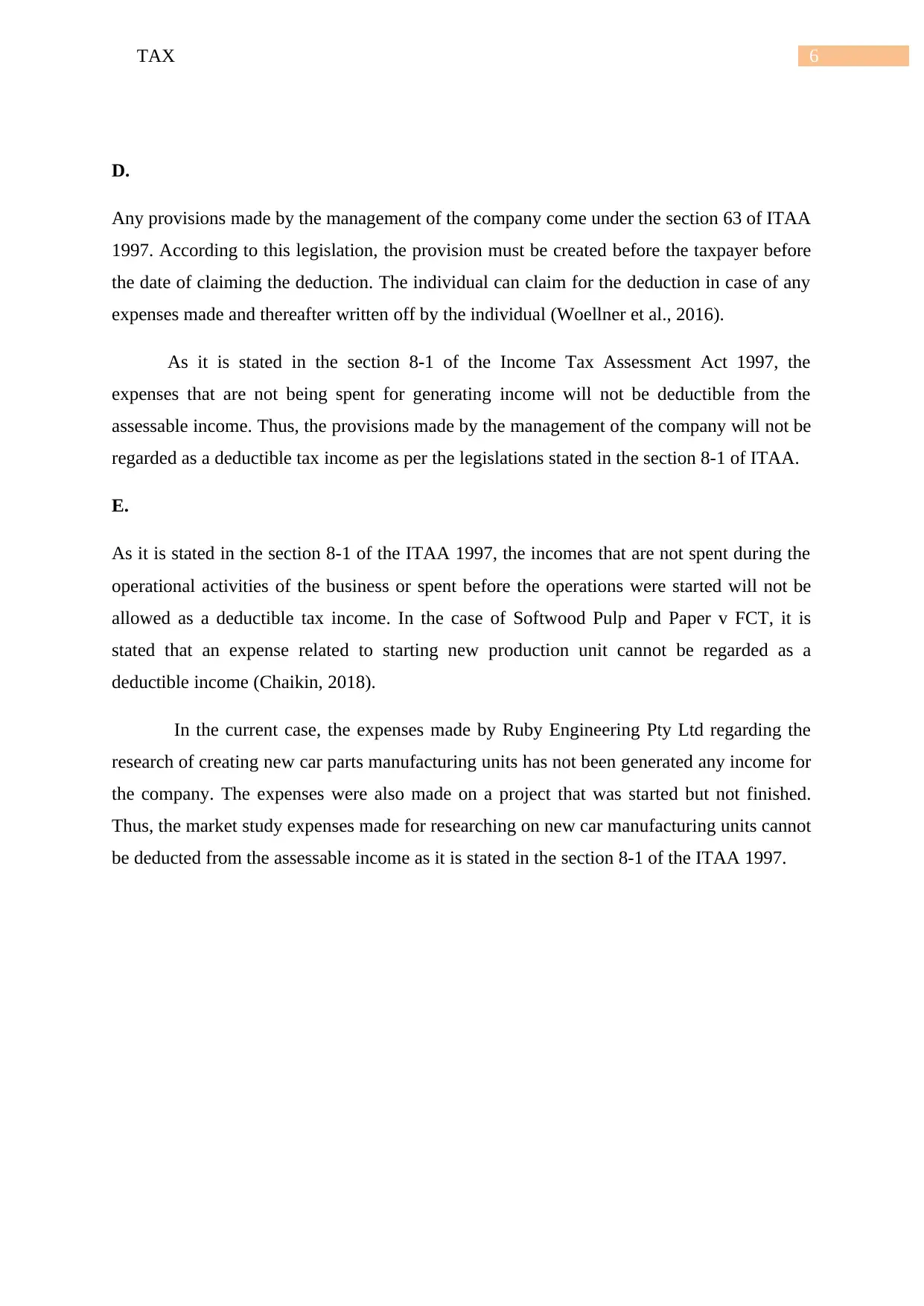
6TAX
D.
Any provisions made by the management of the company come under the section 63 of ITAA
1997. According to this legislation, the provision must be created before the taxpayer before
the date of claiming the deduction. The individual can claim for the deduction in case of any
expenses made and thereafter written off by the individual (Woellner et al., 2016).
As it is stated in the section 8-1 of the Income Tax Assessment Act 1997, the
expenses that are not being spent for generating income will not be deductible from the
assessable income. Thus, the provisions made by the management of the company will not be
regarded as a deductible tax income as per the legislations stated in the section 8-1 of ITAA.
E.
As it is stated in the section 8-1 of the ITAA 1997, the incomes that are not spent during the
operational activities of the business or spent before the operations were started will not be
allowed as a deductible tax income. In the case of Softwood Pulp and Paper v FCT, it is
stated that an expense related to starting new production unit cannot be regarded as a
deductible income (Chaikin, 2018).
In the current case, the expenses made by Ruby Engineering Pty Ltd regarding the
research of creating new car parts manufacturing units has not been generated any income for
the company. The expenses were also made on a project that was started but not finished.
Thus, the market study expenses made for researching on new car manufacturing units cannot
be deducted from the assessable income as it is stated in the section 8-1 of the ITAA 1997.
D.
Any provisions made by the management of the company come under the section 63 of ITAA
1997. According to this legislation, the provision must be created before the taxpayer before
the date of claiming the deduction. The individual can claim for the deduction in case of any
expenses made and thereafter written off by the individual (Woellner et al., 2016).
As it is stated in the section 8-1 of the Income Tax Assessment Act 1997, the
expenses that are not being spent for generating income will not be deductible from the
assessable income. Thus, the provisions made by the management of the company will not be
regarded as a deductible tax income as per the legislations stated in the section 8-1 of ITAA.
E.
As it is stated in the section 8-1 of the ITAA 1997, the incomes that are not spent during the
operational activities of the business or spent before the operations were started will not be
allowed as a deductible tax income. In the case of Softwood Pulp and Paper v FCT, it is
stated that an expense related to starting new production unit cannot be regarded as a
deductible income (Chaikin, 2018).
In the current case, the expenses made by Ruby Engineering Pty Ltd regarding the
research of creating new car parts manufacturing units has not been generated any income for
the company. The expenses were also made on a project that was started but not finished.
Thus, the market study expenses made for researching on new car manufacturing units cannot
be deducted from the assessable income as it is stated in the section 8-1 of the ITAA 1997.
Paraphrase This Document
Need a fresh take? Get an instant paraphrase of this document with our AI Paraphraser
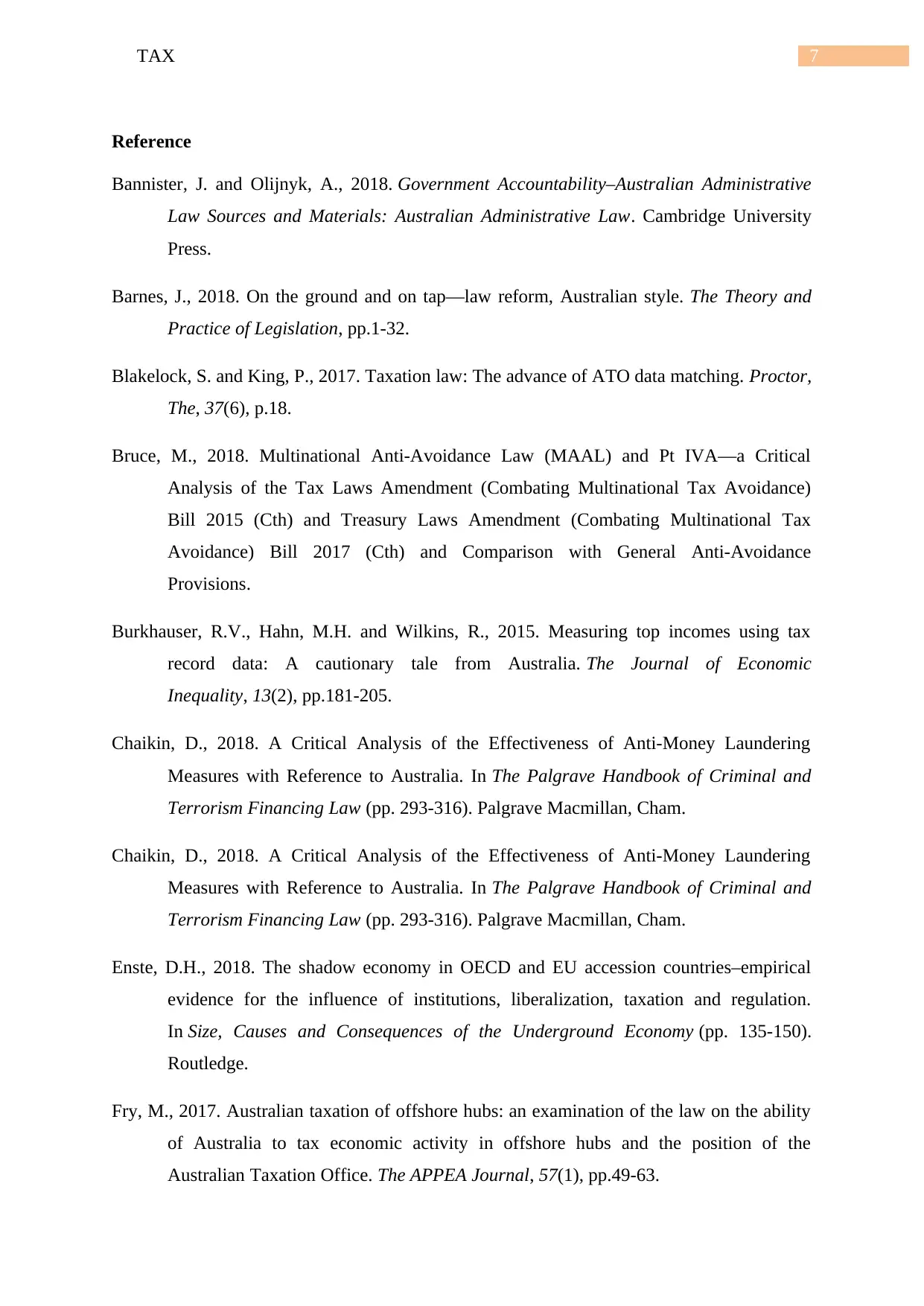
7TAX
Reference
Bannister, J. and Olijnyk, A., 2018. Government Accountability–Australian Administrative
Law Sources and Materials: Australian Administrative Law. Cambridge University
Press.
Barnes, J., 2018. On the ground and on tap—law reform, Australian style. The Theory and
Practice of Legislation, pp.1-32.
Blakelock, S. and King, P., 2017. Taxation law: The advance of ATO data matching. Proctor,
The, 37(6), p.18.
Bruce, M., 2018. Multinational Anti-Avoidance Law (MAAL) and Pt IVA—a Critical
Analysis of the Tax Laws Amendment (Combating Multinational Tax Avoidance)
Bill 2015 (Cth) and Treasury Laws Amendment (Combating Multinational Tax
Avoidance) Bill 2017 (Cth) and Comparison with General Anti-Avoidance
Provisions.
Burkhauser, R.V., Hahn, M.H. and Wilkins, R., 2015. Measuring top incomes using tax
record data: A cautionary tale from Australia. The Journal of Economic
Inequality, 13(2), pp.181-205.
Chaikin, D., 2018. A Critical Analysis of the Effectiveness of Anti-Money Laundering
Measures with Reference to Australia. In The Palgrave Handbook of Criminal and
Terrorism Financing Law (pp. 293-316). Palgrave Macmillan, Cham.
Chaikin, D., 2018. A Critical Analysis of the Effectiveness of Anti-Money Laundering
Measures with Reference to Australia. In The Palgrave Handbook of Criminal and
Terrorism Financing Law (pp. 293-316). Palgrave Macmillan, Cham.
Enste, D.H., 2018. The shadow economy in OECD and EU accession countries–empirical
evidence for the influence of institutions, liberalization, taxation and regulation.
In Size, Causes and Consequences of the Underground Economy (pp. 135-150).
Routledge.
Fry, M., 2017. Australian taxation of offshore hubs: an examination of the law on the ability
of Australia to tax economic activity in offshore hubs and the position of the
Australian Taxation Office. The APPEA Journal, 57(1), pp.49-63.
Reference
Bannister, J. and Olijnyk, A., 2018. Government Accountability–Australian Administrative
Law Sources and Materials: Australian Administrative Law. Cambridge University
Press.
Barnes, J., 2018. On the ground and on tap—law reform, Australian style. The Theory and
Practice of Legislation, pp.1-32.
Blakelock, S. and King, P., 2017. Taxation law: The advance of ATO data matching. Proctor,
The, 37(6), p.18.
Bruce, M., 2018. Multinational Anti-Avoidance Law (MAAL) and Pt IVA—a Critical
Analysis of the Tax Laws Amendment (Combating Multinational Tax Avoidance)
Bill 2015 (Cth) and Treasury Laws Amendment (Combating Multinational Tax
Avoidance) Bill 2017 (Cth) and Comparison with General Anti-Avoidance
Provisions.
Burkhauser, R.V., Hahn, M.H. and Wilkins, R., 2015. Measuring top incomes using tax
record data: A cautionary tale from Australia. The Journal of Economic
Inequality, 13(2), pp.181-205.
Chaikin, D., 2018. A Critical Analysis of the Effectiveness of Anti-Money Laundering
Measures with Reference to Australia. In The Palgrave Handbook of Criminal and
Terrorism Financing Law (pp. 293-316). Palgrave Macmillan, Cham.
Chaikin, D., 2018. A Critical Analysis of the Effectiveness of Anti-Money Laundering
Measures with Reference to Australia. In The Palgrave Handbook of Criminal and
Terrorism Financing Law (pp. 293-316). Palgrave Macmillan, Cham.
Enste, D.H., 2018. The shadow economy in OECD and EU accession countries–empirical
evidence for the influence of institutions, liberalization, taxation and regulation.
In Size, Causes and Consequences of the Underground Economy (pp. 135-150).
Routledge.
Fry, M., 2017. Australian taxation of offshore hubs: an examination of the law on the ability
of Australia to tax economic activity in offshore hubs and the position of the
Australian Taxation Office. The APPEA Journal, 57(1), pp.49-63.
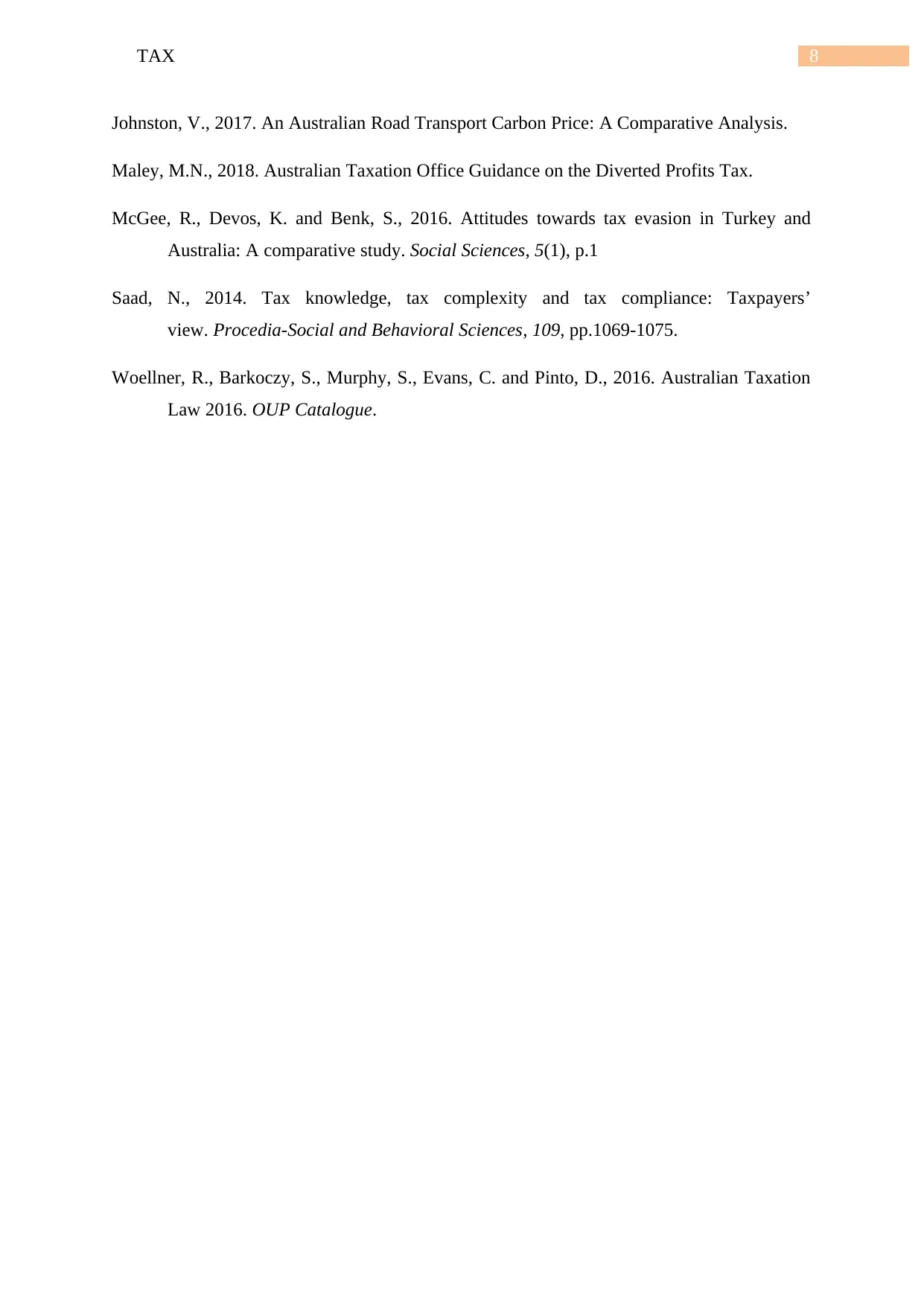
8TAX
Johnston, V., 2017. An Australian Road Transport Carbon Price: A Comparative Analysis.
Maley, M.N., 2018. Australian Taxation Office Guidance on the Diverted Profits Tax.
McGee, R., Devos, K. and Benk, S., 2016. Attitudes towards tax evasion in Turkey and
Australia: A comparative study. Social Sciences, 5(1), p.1
Saad, N., 2014. Tax knowledge, tax complexity and tax compliance: Taxpayers’
view. Procedia-Social and Behavioral Sciences, 109, pp.1069-1075.
Woellner, R., Barkoczy, S., Murphy, S., Evans, C. and Pinto, D., 2016. Australian Taxation
Law 2016. OUP Catalogue.
Johnston, V., 2017. An Australian Road Transport Carbon Price: A Comparative Analysis.
Maley, M.N., 2018. Australian Taxation Office Guidance on the Diverted Profits Tax.
McGee, R., Devos, K. and Benk, S., 2016. Attitudes towards tax evasion in Turkey and
Australia: A comparative study. Social Sciences, 5(1), p.1
Saad, N., 2014. Tax knowledge, tax complexity and tax compliance: Taxpayers’
view. Procedia-Social and Behavioral Sciences, 109, pp.1069-1075.
Woellner, R., Barkoczy, S., Murphy, S., Evans, C. and Pinto, D., 2016. Australian Taxation
Law 2016. OUP Catalogue.
1 out of 9
Related Documents
Your All-in-One AI-Powered Toolkit for Academic Success.
+13062052269
info@desklib.com
Available 24*7 on WhatsApp / Email
![[object Object]](/_next/static/media/star-bottom.7253800d.svg)
Unlock your academic potential
© 2024 | Zucol Services PVT LTD | All rights reserved.





